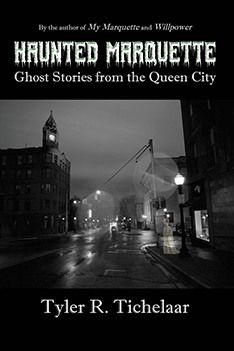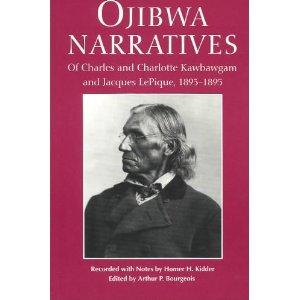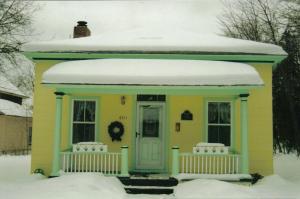Few people who visit Mackinac Island today ever see Anne’s Tablet or even know it exists. It’s a large plaque in the woods by Fort Mackinac, overlooking the lake. The main plaque contains the image of a young girl and has a quote on it from the novel Anne by Constance Fenimore Woolson. In a half-circle around the main plaque are three benches with the titles of Constance Fenimore Woolson’s novels and nonfiction works engraved on their seats.
Although little known today, Constance Fenimore Woolson was a popular American author in the late nineteenth century who was often compared to Harriet Beecher Stowe and George Eliot. Constance Fenimore Woolson: Portrait of a Lady Novelist by Anne Boyd Rioux reminds us that Woolson was far more than just a writer and a lover of Mackinac Island. Because she was a friend of the great novelist Henry James, she has often been reduced to a footnote in his story, but her own story is fascinating, including the role she played in the development of regional Great Lakes literature. Not only did she write about Mackinac Island, but she also wrote about Marquette County, a fact not so surprising since Anne’s Tablet was placed on Mackinac Island in 1916 by Woolson’s nephew, Samuel Mather Jr., one of the major players in the early iron ore industry in Upper Michigan. In fact, Woolson was probably the first author to write fiction set in Marquette, more than three decades before Carroll Watson Rankin published Dandelion Cottage in 1904. The question remains, however, whether she ever visited Marquette.

Constance Fenimore Woolson was one of the best-selling authors of her day and a close friend to Henry James. She traveled the Great Lakes extensively in the 1850s and wrote about them in her later fiction.
Woolson was born in 1840 in New Hampshire, but the family soon moved to Cleveland. Her mother was the niece of James Fenimore Cooper, author of Last of the Mohicans. Woolson’s middle name of Fenimore would later help her break into the literary world. In the 1850s, the family frequently visited Mackinac Island and had a summer cottage there. During this time, it is likely she also traveled widely on Lake Superior. Woolson and her family lived in Cleveland until her father’s death in 1869. She then turned to her pen to help support her mother. They also moved to St. Augustine, Florida, and spent summers in North Carolina. During this time, Woolson began writing and publishing stories about the Great Lakes. After her mother’s death, Woolson moved to Europe in 1879 and lived a wandering life, setting up households in Oxford, Florence, and eventually Venice, where she died in 1894. During these years, she wrote novels and stories set in the American South and Europe, and she published her most popular novel Anne (1882), partly set on Mackinac Island, which sold over 300,000 copies.
Whether Woolson ever set foot in Marquette, Michigan, is unknown, but the evidence suggests it is likely. Woolson’s interest in the area probably began as a result of her sister Georgiana marrying Samuel Livingston Mather in 1850. Mather would later be president of the Cleveland Iron Mining Company (which eventually became Cleveland Cliffs) with interests in Marquette County. Georgiana was the mother of Samuel Mather, Jr. and Katherine Livingston Mather. After Georgiana’s death in 1853, Samuel Livingston Mather married Elizabeth Gwinn, the mother of William Gwinn Mather. Despite her sister’s untimely death, Woolson remained close to her brother-in-law’s family all her life. She likely visited Marquette in the 1850s either during or shortly after her sister’s lifetime, as evidenced by the stories she wrote. In all, Woolson wrote at least three short stories set in Marquette as well as scenes in two of her novels.
Woolson’s first short story set in Marquette is “On the Iron Mountain,” which appeared in Appleton’s Journal on February 15, 1873. The story is about a young woman, Helen Fay, who journeys with a small party of visitors from the East to Marquette. Once there, they decide to see the Iron Mountain, which was a large pile of iron ore located at the mines. Woolson describes the setting as:
Marquette, on Lake Superior, is now a busy town, soon to be a city; it has railroads on shore and fleets of steamers and vessels on the water, people to do business and business to do, all coming from the Iron Mountain behind it. But, in 1853, it was a lonely settlement in the woods, with one little stamping-mill stamping on the ore with wooden legs; a few houses of those hopeful pioneers, who so often sow the seed in the West and so seldom reap the harvest; and a swampy, rocky, sandy, corduroy road, inland to the mine. The Iron Mountain stood there, great and wonderful, waiting for capital. Capital has come, and dug and blasted into its sides for years; but it remains great and wonderful still.
A second story, “Peter the Parson,” appeared in Scribner’s magazine in 1874 and was later reprinted in Woolson’s story collection Castle Nowhere, which includes other stories set on Mackinac Island and in the Great Lakes, including Beaver Island. This story takes place in a mining town named “Algonquin” on the southern shore of Lake Superior. It includes a furnace, stamping mill, and saloon. The story tells the tale of a preacher who is killed by the miners, being struck on the head with a piece of iron ore while the “Iron Mountain” rose behind him. The story received complaints about its ending, but it showed Woolson was striving to do more than create conventional story endings.
The third story, “The Old Five,” was published in Appleton’s Journal in 1876. It is set in a mining town named “Dead River” on the southern shore of Lake Superior. The title refers to the name of the mine in the story. The story includes references to Cornish miners, blueberries, a birch-bark box of Indian sugar, beach agates, and other items of local color. Since the Dead River is just north of Marquette, the fictional town is clearly meant to be Marquette.
Woolson’s novel East Angels (1886) is set in Florida, but the main character, Winthrop, invests in an iron mine on Lake Superior and goes to visit it, seeing a “mountain” of iron ore. In Woolson’s novel Jupiter Lights (1889), part of the setting is in a town called Port aux Pins on Lake Superior, which also seems a likely candidate for Marquette.
One additional piece of Woolson’s published writing that leads to the conclusion she may have visited Marquette is an essay she wrote entitled “Lake Superior,” published in 1876 in Picturesque America, edited by William Cullens Bryant. In this essay, Woolson takes the reader on a circle tour of Lake Superior, describing everything from Sault Ste. Marie to the Pictured Rocks, Keweenaw Peninsula, Apostle Islands, and the north Canadian shore. Of Marquette, she writes, “Marquette comes into view, a picturesque harbor, with a little rock islet, the outlet for the Iron Mountain lying back twelve miles in the interior, a ridge of ore eight hundred feet high, which sends its thousands of tons year after year down to the iron-mills of Cleveland, Pittsburg, and Cincinnati, and scarcely misses them from its massive sides.” The essay is written in third person and is solely descriptive without Woolson offering any hint of personal experiences with the places described, but the descriptions are so detailed, especially of the Pictured Rocks, that it is hard to believe she did not view everything about which she wrote.
Other evidence that Woolson likely drew upon personal experiences for her fictional treatments of Marquette can be found by reading a fragment of a journal that her sister, Georgiana Woolson, wrote (published in the first volume of Five Generations Past, a family history, by Woolson’s niece Clare Benedict). Georgiana kept the journal from June 8 to 29, 1853, during which time her husband, Samuel Livingston Mather, left her in Marquette on her own for two months. The journal includes mention of the Carp River, the forges, and Presque Isle, which she calls “an emerald upon the blue water!” She also mentions two residents, a Miss B— who went with her and an Indian for a ride in a birch-bark canoe, and Ellen who “went in the afternoon to the Carp River with the children of the house.” Ellen may have been Ellen Hewitt, Peter White’s future wife, who would have been sixteen and like Woolson’s family, was from Cleveland, or Ellen Harlow, daughter of town founder Amos Harlow, who was eight at the time. No mention of Woolson is made in the journal, but is it a coincidence that “On the Iron Mountain” is set in 1853, the same year Georgiana visited Marquette?
While Woolson no doubt read Georgiana’s journal, it does not contain descriptions that equate to those in Woolson’s short stories. This distinction suggests Woolson did not rely on family documents but her personal experiences in writing her stories. That said, Woolson must have learned much about Marquette from her Mather relatives. She certainly knew about Peter White from them, which isn’t surprising since her brother-in-law Samuel Livingston Mather’s brother, Henry Mather, lived in Marquette and was married to Mary Hewitt, the sister to Ellen Hewitt, Peter White’s wife. What is surprising is that the one time we know Woolson met Peter White was when she was living in Florence, Italy. In The Complete Letters of Constance Fenimore Woolson, edited by Sharon L. Dean, Woolson writes to her nephew Samuel Mather, Jr. on March 20, 1880:
We saw the Peter Whites before leaving. I was in a book store one day when a gentleman came up and said smilingly, “Is’nt [sic] this Miss Woolson?” I answered that it was, but of course had no idea who he was, as I have never seen Mr White. What follows will be hard for Kate to bear; but tell her to brace up. He then said “I knew you at once from your resemblance to Kate Mather!” I met him again a day later, this time with Mrs Senter, who had just arrived. So Clara and I went over to call upon them, because of their being friends of yours. They were staying in the West Bay two miles and more from our Bay. We saw Mrs White, all the others having gone on some excursion. She looked very delicate and said she was not able to walk at all. She had just received a letter from her sister Mary, and was rejoicing over it. She seemed to us a little homesick, but perhaps that was temporary. She was very pleasant; I have not seen her since I was Clare’s age; I see she has the same fine eyes, and gentle voice she had as a child. They drove over to return our call, but we were unfortunately out, and so did not see them again.
At the time of this letter, Woolson’s niece, Clare Benedict, was eleven, which would suggest Woolson last saw Ellen Hewitt White about 1851. Ellen Hewitt, of course, grew up in Cleveland, so she and Woolson might have known each other as children, or Ellen might have visited Cleveland again after moving to Marquette, or they saw each other in Marquette. Since Woolson had not met Peter White before, her previous meeting with Ellen was in all likelihood before the couple married in 1857. That said, the Whites probably visited Cleveland many times, given that they were spending time with Mrs. Senter, who is likely Delia Wheaton Senter, the widow of George B. Senter, a former mayor of Cleveland.
Some of Woolson’s other letters offer additional clues that she likely visited Marquette. On May 1, 1875, she writes to Paul Hamilton Hayne about her first book, Castle Nowhere, “as I had lived in the Lake-country I wrote of what I knew; the descriptions are all from reality, written down as exactly as possible.” Since “Peter the Parson” was included in Castle Nowhere, does it verify that she visited Marquette?
Another letter to Samuel Mather, on January 17, 1893, testifies that she must have traveled on Lake Superior as far as Minnesota. “I did see prairies in all their splendid wildness; (you were with us,—a baby a few months old). And I did see thousands of wild Indians gathered at La Pointe for their payment a few years later.” The prairies Woolson mentions are likely in Minnesota while La Pointe is in Wisconsin where there was an Indian agency. If Samuel Mather was a baby at the time, this trip to the prairies must have been in the fall of 1851 since Samuel was born July 13, 1851 and autumn was when the government typically made annuity payments to the Native American tribes. Woolson would have only been eleven at the time. The second trip to La Pointe a few years later likely was to the Indian agency in either Sandy Lake, Minnesota, or Superior or Bayfield, Wisconsin. The agency moved around a lot in the 1850s, and despite its name, it was not always in La Pointe. If Woolson traveled so far west on Lake Superior with her sister and baby Samuel, she likely would have stopped in Marquette as well.
If Woolson did not visit Marquette—and it’s important to note she never said that she didn’t—the other probability is that her fiction was inspired by stories the Mathers told her. The Mathers seem to have been storytellers themselves since in an April 25, 1875 letter, Woolson suggests to her nephew Samuel that he write his own stories, saying he has “every qualification” to do so. She certainly encouraged her Mather niece and two nephews in their love of literature. In a letter dated September 13, 1888 to Mary Mapes Dodge, author of Hans Brinker, or the Silver Skates and editor of a children’s magazine, she writes, “all of my life—long before I began to write—I have been a teller of stories to children. Endless stories; stories that went on for months & years,—oral serials. One of my nephews, a man six feet high, with a black beard, re-told to me one of my serials (in outline) at Sorrento, some years ago, so that his young bride could also hear it!” This nephew is Samuel, who visited her in Italy on his honeymoon.
Samuel Mather, Jr. also must have mentioned Marquette in his letters to his aunt because on January 22, 1888, Woolson asks him, “Did the Marquette Fay really discover a gold mine?” This comment probably refers to James S. Fay, President of the Lake Superior Iron Company, who found a vein of gold and silver on the Ishpeming gold range in the summer of 1887.
But perhaps most fascinating of all is when Woolson writes to Samuel on January 9, 1893, sending him part of the draft of her last novel Horace Chase (which not surprisingly also has a passing reference to Marquette) and asking him to give her advice and make corrections to it. Her primary concerns are whether the conversation is natural and whether the threat that one character makes to another is realistic. She asks Sam to read the novel aloud so “Will” (William Gwinn Mather) can give his advice also. Sam apparently did as requested because on March 14, 1893, she writes to thank him for his “excellent corrections” and says “They went to N.Y. an hour after their arrival here.” Sam’s corrections could not have been too extensive since Woolson made them so quickly, but the situation makes one wonder what other literary advice or material Mather provided for his aunt.
Less than a year after this letter, Woolson died on January 24, 1894. At the very end of her life, Woolson had been very ill, having spent many years suffering from hearing loss, chronic depression, and insomnia, but she also came down with a major illness after Christmas, for which her doctor gave her laudanum. Scholars still debate whether her final illness was influenza, a gallbladder inflammation, a bowel obstruction, or pancreatitis. In any case, perhaps drowsy or dizzy from the laudanum, she got out of her bed in her apartment in Venice that last night and opened her window. She then either accidentally fell out of the window or intentionally committed suicide, landing three stories below on the pavement.
Following Woolson’s death, her sister and niece, Clara and Clare Benedict, went to Venice to clean out her apartment, and they were helped by Henry James. According to Sharon Dean, the editor of her letters, Woolson probably burned many of her letters for her own privacy and that of her correspondents, but the Benedicts and James may have also burned letters. Those letters might have included some from the Mathers that would have offered more information on Woolson’s treatment of Marquette in her fiction.
Woolson’s death made international news and was not unnoticed in Marquette. On Tuesday, January 30, 1894, the Mining Journal carried a small story stating that Samuel Mather, Jr. had heard of her death two days before in Cleveland. The newspaper noted “Her death has caused great sorrow among her many admirers in this vicinity.” While the article goes on to mention several of Woolson’s books, it does not state whether Woolson ever visited Marquette. Perhaps the source of Woolson’s information about Marquette will never be solved, but regardless, Woolson can be considered Marquette’s first author.
More information about Woolson can be found at the Constance Fenimore Woolson Society’s website at https://constancefenimorewoolson.wordpress.com/, including links to the three short stories referenced here. Woolson’s novels are all still in print and a new collection of her short stories has just been published.
Special thanks for their help in researching this article are due to Woolson scholars Anne Boyd Rioux and Victoria Brehm, to Beth Gruber at the Marquette Regional History Center, to Dawn Gallo at Peter White Public Library, and to Anne St. Onge at the Mackinac Island Public Library. Thanks is also owed to Jennifer Lammi for editing an earlier version of this article which appeared in 2016 in Harlow’s Wooden Man, the quarterly publication of the Marquette Regional History Center.
____________
Tyler R. Tichelaar is proud to be a seventh generation resident of Marquette. He is the author of eight novels set in Marquette, including The Marquette Trilogy and When Teddy Came to Town; the history books My Marquette: Explore the Queen City of the North and Haunted Marquette: Ghost Stories from the Queen City; and the play Willpower, about Will Adams, Marquette’s ossified man, which was produced by the Marquette Regional History Center at Kaufman Auditorium in 2014. His next book Kawbawgam, a biography of Ojibwa Chief Charles Kawbawgam, will be released in November 2020. For more information on Tyler and his books, visit www.MarquetteFiction.com.














![iron_pioneers_cover[1] Iron Pioneers The marquette trilogy book one tyler r. tichelaar](https://tylerrtichelaar.files.wordpress.com/2011/07/iron_pioneers_cover1.jpg?w=450)


